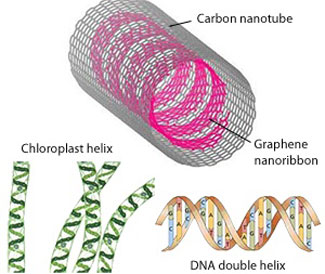| Jun 06, 2011 |
Carbon nanosystems: Curled-up from within
|
|
(Nanowerk News) Single-walled carbon nanotubes (CNTs) are rolled-up one-dimensional versions of graphene. CNTs have attracted significant interest over the past two decades, not only for their excellent mechanical and electrical properties, but also because their hollow, cylindrical structure allows them to serve as nanosized containers, templates in material fabrication, or even molecular delivery systems. Due to their nanoscale dimensions, filling CNTs with other nanostructures can also alter the properties of both the tubes and 'fillers' in unexpected ways.
|
|
A theoretical study by Hui Li and colleagues from Shandong University in China ("Helical Encapsulation of Graphene Nanoribbon into Carbon Nanotube") has now shown that when introduced into CNTs, graphene nanoribbons curl up mimicking the helical structures responsible for photosynthesis in some plant cells. Moreover, when pairs of ribbons are encapsulated in the nanotubes at the same time, they form DNA-like double-helix structures.
|
 |
| Schematic illustrations of the nanotube–nanoribbon structure (top) and comparable helical structures in nature (bottom). (© 2011 ACS)
|
|
The helical shapes arise because of complex interactions between competing forces. "The van der Waals force traps the nanoribbon in the nanotube, while the formation of the nanoribbon helix occurs through – stacking interactions between the nanoribbon and nanotube." explains Li, one of the scientists behind the research. The stacking interaction is an intermolecular interaction between the hexagonal carbon rings forming both the nanoribbon strips and the nanotube walls. As the researchers' time-resolved atomistic calculations show, the competition between the repulsive and attractive components of this unique combination of interactions forces the nanoribbon to curl up into a helical shape when introduced into a CNT (see image).
|
|
The helical nanoribbon structure is similar to the chloroplast in a type of green algae called spirogyra, where the helical shape is believed to make photosynthesis and starch storage more efficient. The researchers also found another similarity with natural systems: simulations of the molecular dynamics of a pair of nanoribbons in a CNT revealed that they form reverse double-helix structures that closely resemble the structure of double-stranded DNA.
|
|
Demonstrating the potential applications of this discovery, the researchers also performed calculations showing that the nanoribbon–nanotube system can carry water and cinnamide molecules, important substances in biology and medicine. "We could, for example, distribute drugs or catalysts on-demand, making use of the nanoscale confined space in the nanotubes," says Li.
|

